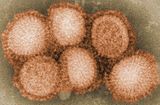Our website is made possible by displaying online advertisements to our visitors.
Please consider supporting us by disabling your ad blocker.
Influenza A virus subtype H1N1
| Influenza A virus subtype H1N1 | |
|---|---|

| |
| Virus classification | |
| (unranked): | Virus |
| Realm: | Riboviria |
| Kingdom: | Orthornavirae |
| Phylum: | Negarnaviricota |
| Class: | Insthoviricetes |
| Order: | Articulavirales |
| Family: | Orthomyxoviridae |
| Genus: | Alphainfluenzavirus |
| Species: | |
| Serotype: | Influenza A virus subtype H1N1
|
| Strains | |
| Influenza (flu) |
|---|
 |
Influenza A virus subtype H1N1 (A/H1N1) is a subtype of influenza A virus (IAV). Some human-adapted strains of H1N1 are endemic in humans and are one cause of seasonal influenza (flu).[1] Other strains of H1N1 are endemic in pigs (swine influenza) and in birds (avian influenza).[2] Subtypes of IAV are defined by the combination of the antigenic H and N proteins in the viral envelope; for example, "H1N1" designates an IAV subtype that has a type-1 hemagglutinin (H) protein and a type-1 neuraminidase (N) protein.[3]
All subtypes of IAV share a negative-sense, segmented RNA genome.[1] Under rare circumstances, one strain of the virus can acquire genetic material through genetic reassortment from a different strain and thus evolve to acquire new characteristics, enabling it to evade host immunity and occasionally to jump from one species of host to another.[4][5] Major outbreaks of H1N1 strains in humans include the 1918 Spanish flu pandemic, the 1977 Russian flu pandemic and the 2009 swine flu pandemic, all of which were caused by strains of A(H1N1) virus which are believed to have undergone genetic reassortment.[6]
Each year, three influenza strains are chosen for inclusion in the forthcoming year's seasonal flu vaccination by the Global Influenza Surveillance and Response System of the World Health Organization (WHO). Since 1999, every annual formulation has included one strain of A/H1N1 as well as two other influenza strains - together representing strains thought most likely to cause significant human suffering in the coming season.[7][8][9]
- ^ a b "Influenza A Subtypes and the Species Affected | Seasonal Influenza (Flu) | CDC". Centers for Disease Control and Prevention. 13 May 2024. Retrieved 17 June 2024.
- ^ Jilani TN, Jamil RT, Siddiqui AH (30 November 2020). "H1N1 Influenza". H1N1 Influenza in StatPearls. StatPearls. PMID 30020613. Archived from the original on 12 March 2020. Retrieved 25 August 2020.
- ^ CDC (1 February 2024). "Influenza Type A Viruses". Centers for Disease Control and Prevention. Retrieved 3 May 2024.
- ^ Shao W, Li X, Goraya MU, Wang S, Chen JL (August 2017). "Evolution of Influenza A Virus by Mutation and Re-Assortment". International Journal of Molecular Sciences. 18 (8): 1650. doi:10.3390/ijms18081650. PMC 5578040. PMID 28783091.
- ^ Eisfeld AJ, Neumann G, Kawaoka Y (January 2015). "At the centre: influenza A virus ribonucleoproteins". Nature Reviews. Microbiology. 13 (1): 28–41. doi:10.1038/nrmicro3367. PMC 5619696. PMID 25417656.
- ^ Clancy, Susan (2008). "Genetics of the Influenza Virus | Learn Science at Scitable". www.nature.com. Nature Education 1(1):83. Retrieved 17 August 2024.
- ^ "Seasonal Flu Vaccines | CDC". Centers for Disease Control and Prevention. 12 March 2024. Retrieved 19 August 2024.
- ^ "Global Influenza Surveillance and Response System (GISRS)". World Health Organization. Archived from the original on 3 October 2011. Retrieved 22 October 2019.
- ^ Anker M, Schaaf D, World Health Organization (2000). WHO report on global surveillance of epidemic-prone infectious diseases (PDF) (Report). World Health Organization (WHO). hdl:10665/66485. WHO/CDS/CSR/ISR/2000.1. Archived (PDF) from the original on 31 October 2022.
Previous Page Next Page


